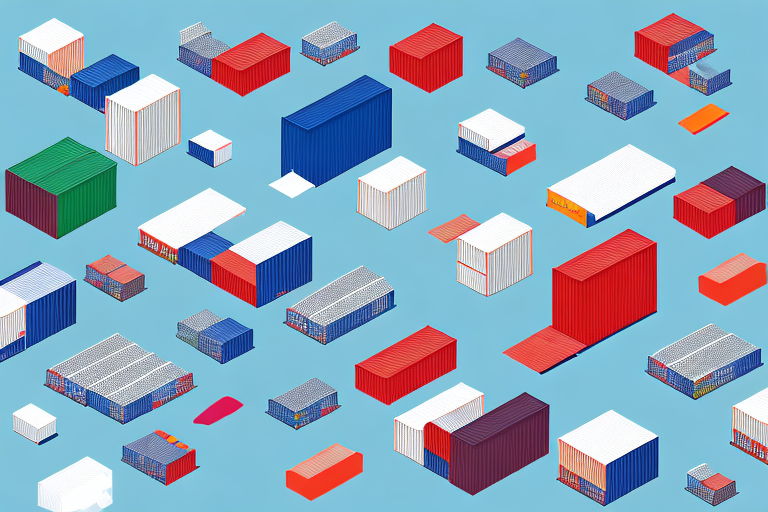The Benefits of E-Commerce Logistics and Freight Management
E-commerce continues to dominate the retail landscape, with global online sales projected to reach $6.54 trillion by 2023 (Statista, 2023). Effective logistics and freight management are pivotal in supporting this growth, encompassing the transportation, storage, and delivery of online purchases. Implementing robust strategies in this area offers numerous advantages, including:
- Enhanced Customer Satisfaction: Timely and reliable deliveries boost customer trust and loyalty.
- Increased Sales: Efficient logistics can handle higher order volumes, driving revenue growth.
- Improved Profit Margins: Streamlined operations reduce costs, enhancing overall profitability.
This article delves into the fundamentals of e-commerce logistics and freight management, exploring key strategies, challenges, technological advancements, and future trends that shape the industry's landscape.
Fundamentals of E-Commerce Logistics and Freight Management
E-commerce logistics and freight management involve orchestrating the complex supply chain that delivers products from manufacturers to consumers. This process includes multiple stakeholders such as manufacturers, distributors, retailers, and carriers, all collaborating to ensure seamless operations. The logistics workflow typically comprises the following stages:
- Order Processing: Managing incoming orders and initiating fulfillment.
- Inventory Management: Tracking stock levels to meet demand without overstocking.
- Picking and Packing: Selecting products from inventory and preparing them for shipment.
- Shipping: Transporting goods to distribution centers or directly to customers.
- Delivery: Finalizing the delivery to the customer's doorstep.
One of the most significant challenges in e-commerce logistics is last-mile delivery. This final step often incurs the highest costs and complexities due to factors like traffic congestion, address inaccuracies, and ensuring deliveries to the correct recipients. Innovations such as drone deliveries and autonomous vehicles are being explored to mitigate these challenges and enhance efficiency.
Additionally, managing returns, or reverse logistics, is crucial. With the rise of online shopping, consumers expect hassle-free return processes. Efficient return management not only reduces costs but also fosters customer loyalty by providing a positive post-purchase experience.
Key Elements of an Effective Logistics and Freight Management Strategy
Customer Satisfaction
Prioritizing delivery speed, product quality, and process efficiency is essential to meet and exceed customer expectations. Satisfied customers are more likely to become repeat buyers and advocate for the brand.
Technology Utilization
Advanced software systems for inventory management, real-time tracking, and data analytics streamline operations, enhance visibility, and facilitate informed decision-making. Technologies such as Warehouse Management Systems (WMS) and Transportation Management Systems (TMS) are integral to modern logistics.
Supply Chain Collaboration
Seamless cooperation between manufacturers, distributors, retailers, and carriers ensures an efficient supply chain. Collaborative efforts help in forecasting demand, managing inventory, and optimizing transportation routes.
Adaptability
The ability to swiftly respond to market fluctuations, regulatory changes, and supply chain disruptions is vital. Flexibility in operations allows businesses to maintain service levels and adapt to evolving consumer demands.
The Role of Technology in Streamlining Logistics and Freight Management
Technology is a cornerstone of modern e-commerce logistics, driving efficiency and reducing costs. Key technological advancements include:
- Inventory Management Software: Facilitates real-time tracking of inventory, ensuring products are available for timely shipping.
- Real-Time Tracking: Provides visibility across the supply chain, enabling businesses to monitor shipments and adjust as needed.
- Data Analytics: Leverages data to identify trends, forecast demand, and optimize shipping routes, leading to cost savings.
Automation also plays a critical role. Automated warehouses, equipped with robotics for picking and packing, reduce reliance on manual labor and accelerate order fulfillment. Furthermore, blockchain technology is emerging as a tool to enhance supply chain transparency and security by providing immutable transaction records.
Challenges in E-Commerce Logistics and Freight Management
Despite its advantages, e-commerce logistics faces several challenges:
- Inventory Management: Balancing inventory to avoid stockouts and overstocking requires precise forecasting and real-time monitoring.
- Timely Delivery: Ensuring on-schedule deliveries is critical for maintaining customer satisfaction and competitive edge.
- Return Handling: Efficiently managing returns minimizes costs and maintains inventory accuracy.
- Shipping Costs: Controlling expenses related to transportation and delivery is essential for profitability.
- Supply Chain Complexity: Navigating a multifaceted supply chain with numerous stakeholders demands robust management strategies.
- Regulatory Compliance: Adhering to customs, import/export laws, and other regulations is mandatory to avoid legal issues and delays.
To address these challenges, e-commerce companies are investing in technologies like automation and partnering with third-party logistics providers (3PLs) to enhance efficiency and reduce shipping times. Staying updated with the latest industry trends and innovations is crucial for maintaining competitiveness.
Outsourcing Logistics: Enhancing Efficiency with Third-Party Providers
Outsourcing logistics and freight management to third-party logistics providers (3PL) can significantly enhance operational efficiency for e-commerce businesses. By leveraging the expertise, capabilities, and infrastructure of 3PLs, businesses can streamline their supply chains. Key benefits include:
- Advanced Software Systems: Access to sophisticated inventory management, real-time tracking, and data analysis tools.
- Logistics Operations: Efficient handling of picking, packing, and shipping processes, leading to time and cost savings.
- Regulatory Compliance: Assistance in navigating shipping regulations and ensuring compliance with customs and import/export laws.
- Cost Reduction: Economies of scale achieved through the 3PL's established infrastructure and network.
Moreover, outsourcing allows businesses to expand their market reach and enter new regions by utilizing the global network of warehouses and distribution centers that 3PLs provide. This enables seamless international shipping and access to new customer bases. Additionally, businesses benefit from the latest technologies and innovations that 3PLs employ, ensuring they stay competitive and adaptable to changing market conditions.
The Importance of Real-Time Tracking in Logistics and Freight Management
Real-time tracking is a pivotal component of e-commerce logistics, offering numerous advantages for both businesses and customers. Utilizing real-time tracking software enables businesses to:
- Monitor shipment progress and identify potential delays
- Ensure timely deliveries and improve customer satisfaction
- Reduce the risk of lost or damaged shipments
- Gather valuable data for optimizing supply chain operations
For customers, real-time tracking enhances transparency by allowing them to monitor their orders' status, building trust and confidence in the business. Accurate delivery estimates help manage customer expectations and reduce the volume of inquiries and complaints related to shipment statuses.
From an inventory management perspective, real-time tracking assists businesses in maintaining optimal inventory levels by providing up-to-date information on stock movement and shipment statuses. This reduces the likelihood of stockouts and overstocking, which can lead to lost sales or increased holding costs. Additionally, analyzing shipping data can reveal trends and patterns that inform strategic decisions on inventory management and product offerings.
Best Practices for Efficient Inventory Management
Efficient inventory management is critical for effective e-commerce logistics. Implementing best practices can help businesses maintain optimal inventory levels, minimize holding costs, and enhance order fulfillment processes. Key best practices include:
- Real-Time Inventory Monitoring: Using software to continuously track inventory levels and update stock information in real-time.
- Demand Forecasting: Analyzing historical sales data and market trends to predict future demand and adjust inventory accordingly.
- Safety Stock Management: Maintaining a buffer of stock to prevent stockouts during demand surges or supply chain disruptions.
- Just-in-Time (JIT) Inventory Systems: Implementing JIT systems where inventory is ordered and delivered only when needed, reducing holding costs and minimizing excess inventory.
Employing a just-in-time inventory management system can be particularly effective. JIT systems optimize inventory levels by synchronizing supply with demand, thereby reducing the costs associated with overstocking and excess storage.
Cost Reduction Strategies in Logistics and Freight Management
Effective logistics and freight management can lead to substantial cost savings for e-commerce businesses. Strategies to reduce costs include:
- Streamlining the Supply Chain: Simplifying the supply chain to reduce complexity and eliminate inefficiencies.
- Leveraging Technology: Utilizing software and automation to enhance operational efficiency and lower labor costs.
- Optimizing Shipping Routes: Planning the most efficient shipping routes to minimize transportation costs and delivery times.
- Outsourcing to 3PLs: Partnering with third-party logistics providers to benefit from their economies of scale and established infrastructure.
- Data Analytics: Analyzing logistics data to identify inefficiencies and implement targeted strategies for improvement.
By focusing on these areas, businesses can reduce expenses related to shipping, inventory holding, and labor, ultimately enhancing their profitability.
Future Trends in E-Commerce Logistics and Freight Management
The e-commerce sector is continually evolving, and logistics and freight management are adapting to meet new demands and challenges. Future trends shaping this landscape include:
- Automation: Increased use of robotics and automated systems in warehouses and fulfillment centers to enhance efficiency and accuracy.
- Sustainability: Growing emphasis on environmentally friendly practices, such as using electric delivery vehicles and optimizing packaging to reduce waste.
- Real-Time Tracking and Data Analysis: Enhanced tracking capabilities and the use of big data analytics to improve supply chain visibility and decision-making.
- Same-Day and Next-Day Delivery: Continued demand for faster delivery options, driving investments in infrastructure and technology to meet these expectations.
- Artificial Intelligence (AI) and Machine Learning: Leveraging AI to forecast demand, optimize routing, and automate customer service interactions.
Staying ahead of these trends will be crucial for e-commerce businesses aiming to maintain a competitive advantage and meet the evolving needs of their customers.
Case Studies: Successful Logistics and Freight Management Implementations
Numerous businesses have successfully implemented logistics and freight management strategies, yielding significant benefits. Notable examples include:
- Amazon: Amazon has heavily invested in its logistics network, including fulfillment centers, transportation fleets, and advanced automation technologies. This investment has resulted in faster delivery times, lower shipping costs, and heightened customer satisfaction.
- Target: Target has implemented real-time tracking systems for its shipments, allowing for precise monitoring and timely adjustments to the delivery process. This has improved operational efficiency and enhanced the customer experience.
- Walmart: Walmart has integrated automation and data analytics into its logistics operations, leading to significant cost savings and increased efficiency across its supply chain.
These case studies demonstrate the tangible benefits of strategic logistics and freight management in the e-commerce sector.
Conclusion
Effective e-commerce logistics and freight management are essential for businesses aiming to thrive in the competitive digital marketplace. By focusing on customer satisfaction, leveraging advanced technologies, and fostering collaboration across the supply chain, businesses can enhance the speed and efficiency of their logistics operations. Additionally, outsourcing to third-party logistics providers (3PL) can offer access to advanced systems, infrastructure, and expertise, resulting in significant cost savings. Staying informed about future trends such as automation, sustainability, and real-time tracking will ensure businesses remain competitive and responsive to the dynamic demands of e-commerce logistics and freight management.






















